Sukiyaki Don is your favorite Japanese hot pot reimagined as the ultimate beef rice bowl. Bursting with sweet, salty, and savory flavors, this donburi with tofu and veggies is just as hearty and delicious as traditional sukiyaki. Ready in 15 minutes!
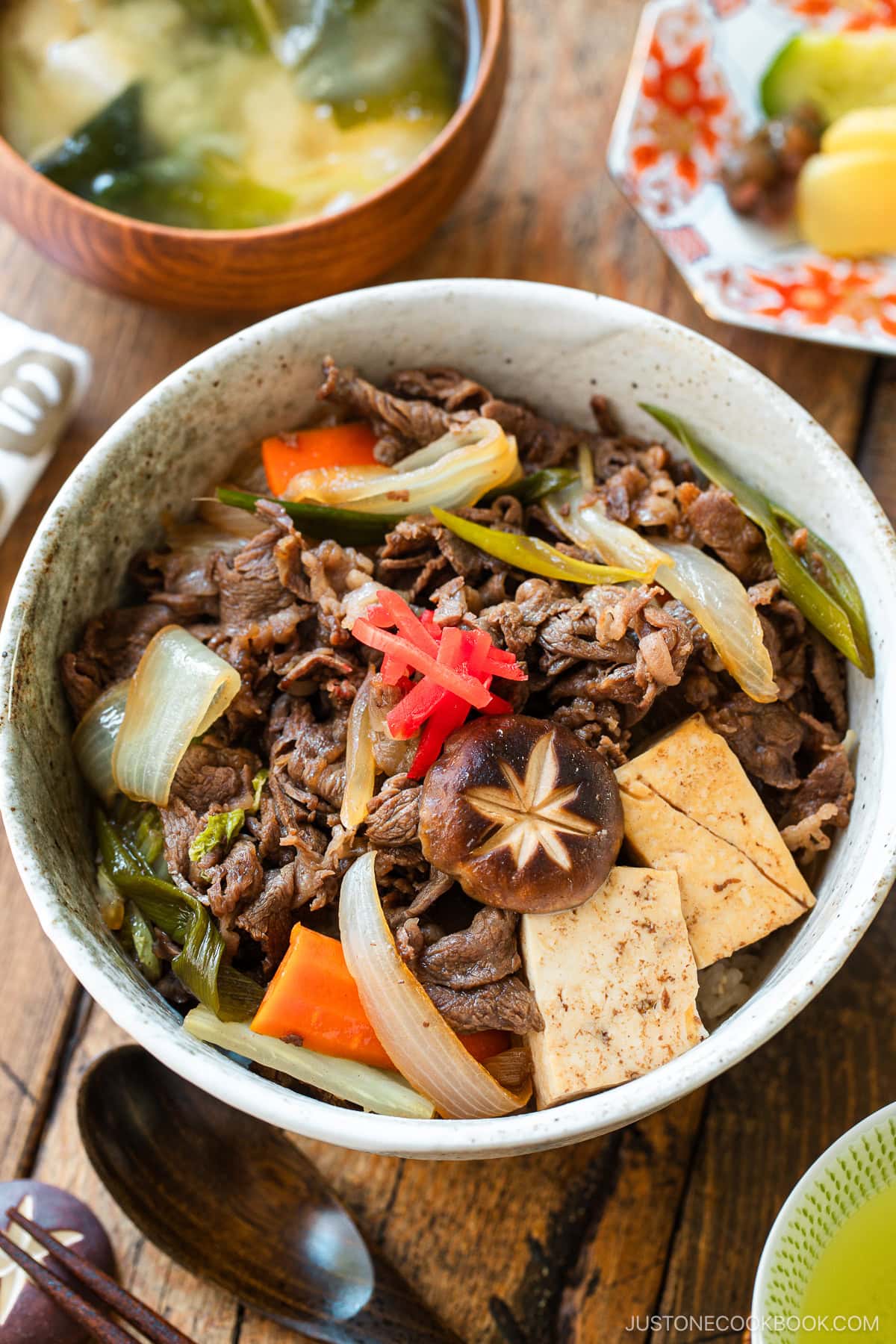
If you enjoy the famous Japanese beef hot pot Sukiyakithen you’ll love it served over a rice bowl like in today’s recipe, Sukiyaki Don. I’m a big fan of meals that deliver maximum flavor and comfort with minimal effort, and this sweet-and-savory dish hits those marks. It takes just 15 minutes to get this nutritious and satisfying beef donburi on the table!
Looking for more delicious rice bowl dishes? Try my Gyudon, Oyakodonand Katsudon recipes next!
What is Sukiyaki Don?
Sukiyaki don (すき焼き丼) is the rice bowl rendition of sukiyaki, the classic Japanese beef hot pot. It features marbled, thin-sliced beef that’s pan-grilled and simmered with vegetables, tofu, and mushrooms in a sweet-savory sauce and served over steamed rice. With more colorful ingredients and a sweeter flavor profile than its cousin gyudon, sukiyaki don is robust and lavish in the most delicious way.
Why I Love This Recipe
- A balanced one-bowl meal. It’s the perfect satisfying mix of steamed rice, pan-grilled beef, crisp vegetables, shiitake mushrooms, tender tofu, and sweet umami sauce.
- Fast and simple! You need only 5 minutes to prep and 10 minutes to cook it. Especially on a busy weeknight, I love that I can get this meal on the table in just 15 minutes.
- Quick clean up. It takes just one pan to make this dish. Clean up couldn’t be easier!
- Easy to customize. You can swap the proteins and vegetables with whatever you have in the fridge, or make it vegetarian or vegan-friendly.
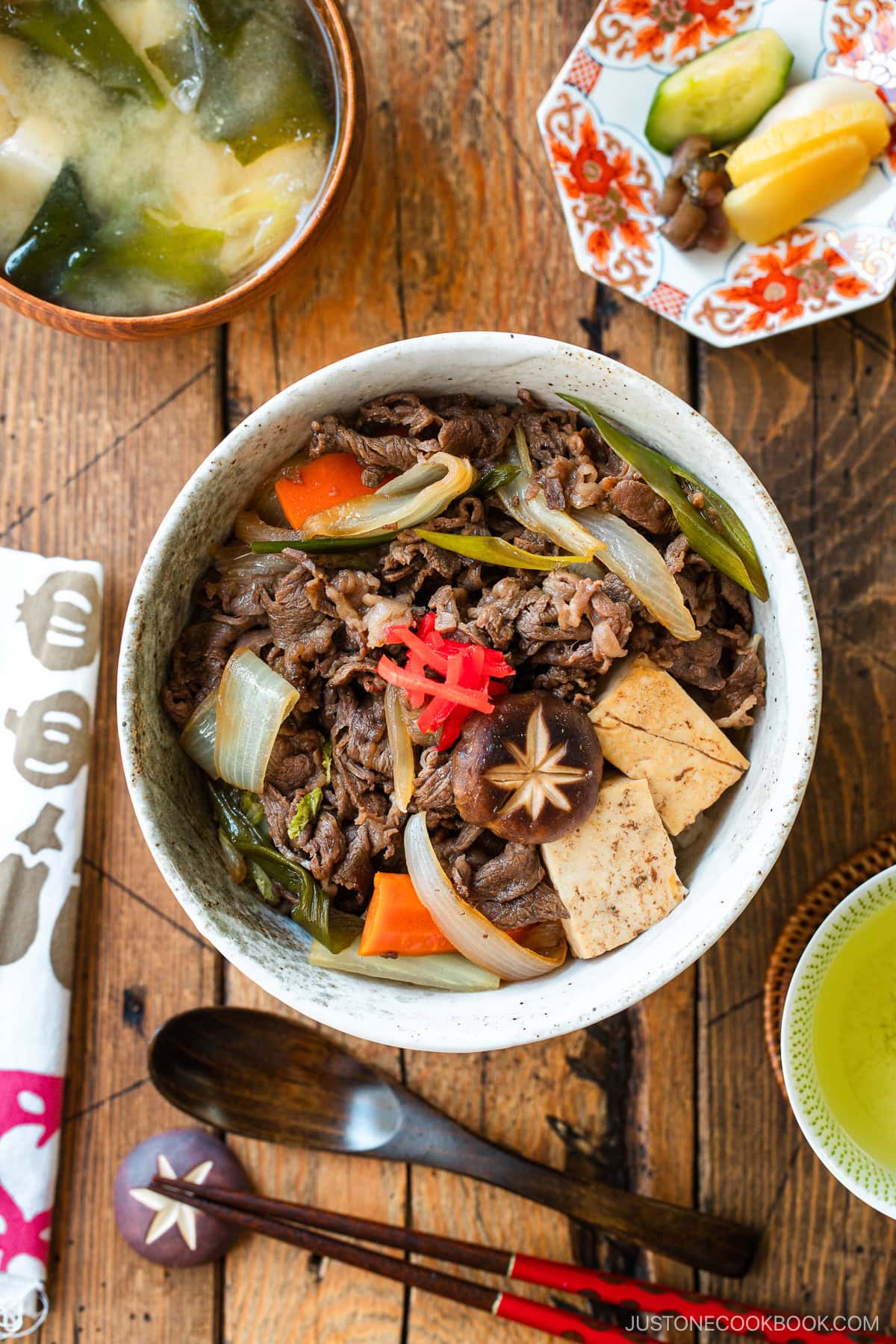
Ingredients for Sukiyaki Don
- Thinly sliced beef (well marbled)
- Tokyo negi (naga negi or long green onion)
- Onion
- Shiitake mushrooms
- Medium-firm tofu
- Napa cabbage
- Carrot
- Cooked Japanese short-grain rice
- Pickled red ginger (beni shoga or kizami beni shoga) – optional, for garnish
- Sukiyaki sauce:
- Sugar
- Sake
- Mirin
- I am willow
- Dashi
Find the printable recipe with measurements below.
Substitutions
- Thinly sliced beef – I recommend well-marbled chuck or ribeye, which you can purchase pre-sliced at Japanese or Asian supermarkets. If you can’t find it, you can slice your own at home; see my tutorial How to Slice Meat Thinly.
- Shiitake mushrooms – You can use enoki, maitake, shimeji, and/or oyster mushrooms. too. I typically use three different types of mushrooms when I make classic sukiyaki and my family loves the variety!
- Tokyo negi – If you can’t find this Japanese long green onion, then several green onions/scallions will do.
- Sake and mirin – These Japanese pantry ingredients add a wonderful depth of flavor to the simmering liquid. For a non-alcoholic alternative, you can substitute them with broth (dashi) or water.
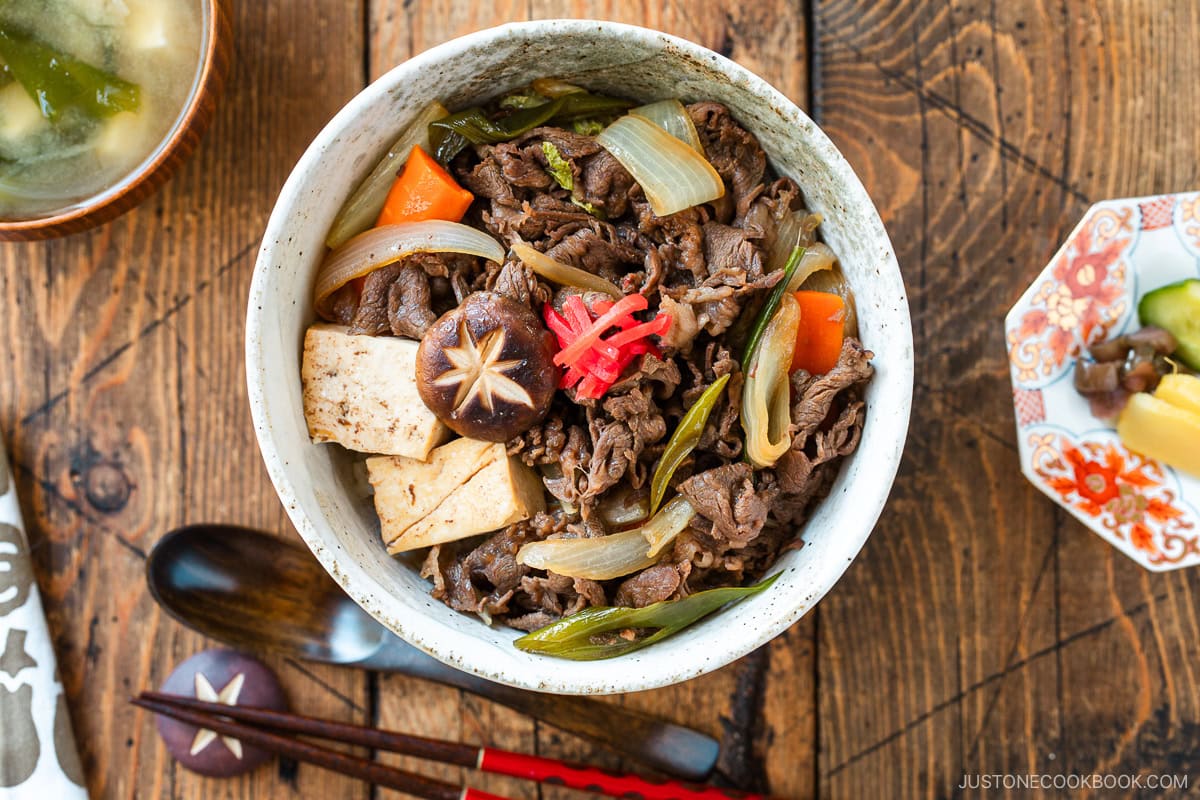
How To Make Sukiyaki Don
Preparation
Step 1 – Prepare all the ingredients. Prepare your hot steamed rice ahead of time. To use frozen rice, reheat it before you assemble the donburi. Cut the vegetables and tofu into bite-size pieces and trim the mushrooms.
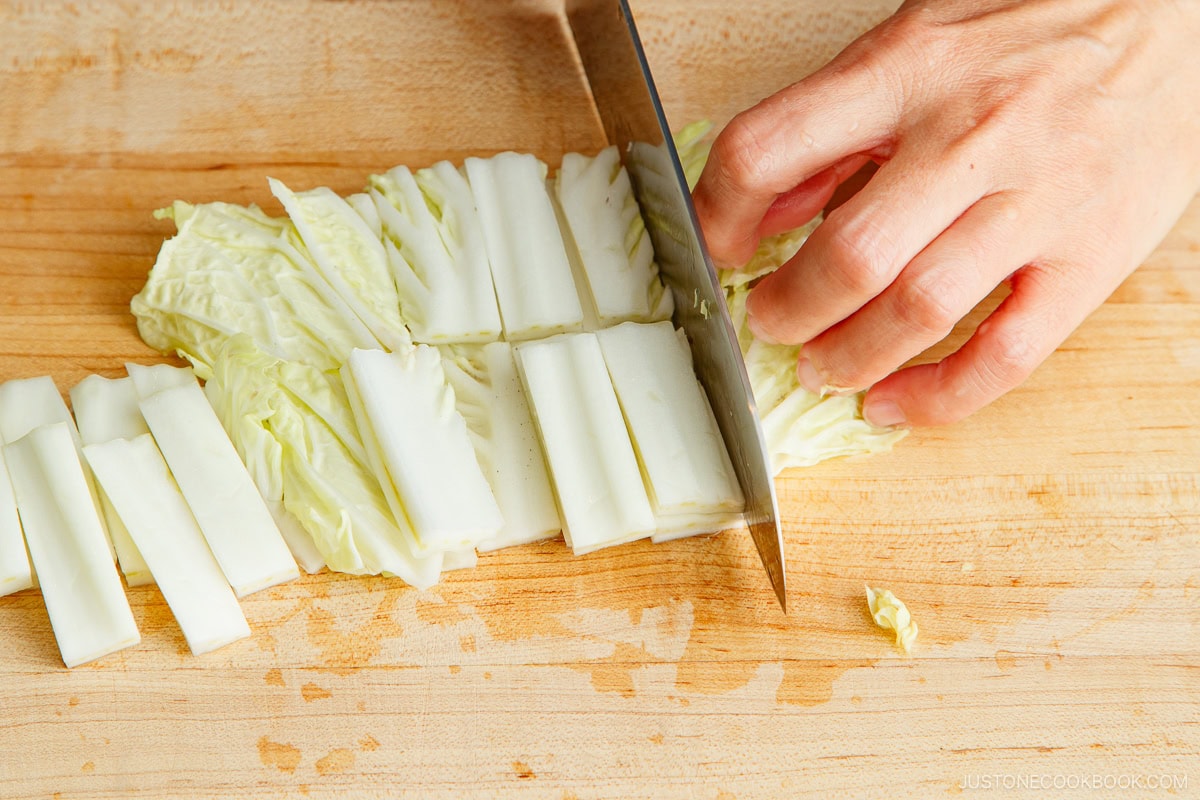
Cooking
Step 2 – Grill the beef slices. In a large frying pan over medium-high heat, quickly sear the meat on one side, then flip over.
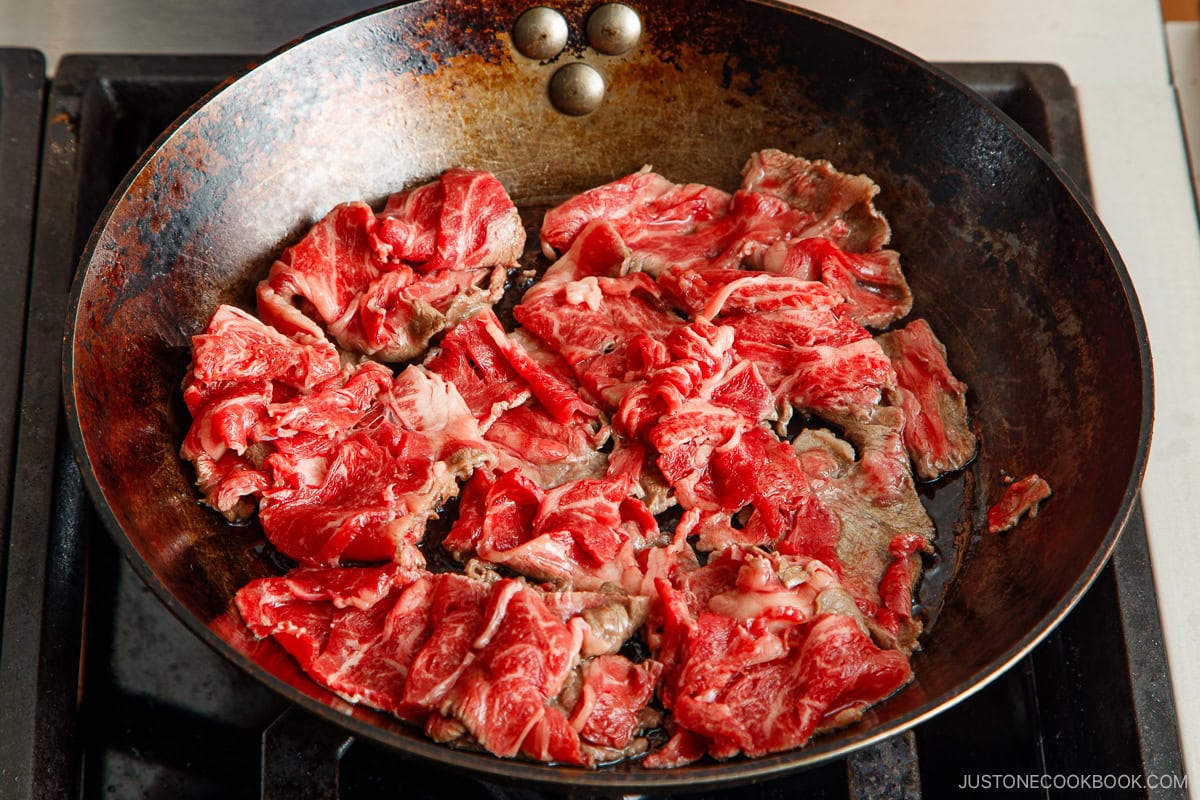
Step 3 – Add the thick vegetables and seasonings. As you sear the beef on the other side, add and sear the onion and white part of the negi. Mix together with the beef, then add the carrots and thick white parts of the napa cabbage. Then, add the sugar, sake, mirin, soy sauce, and dashi to the pan.
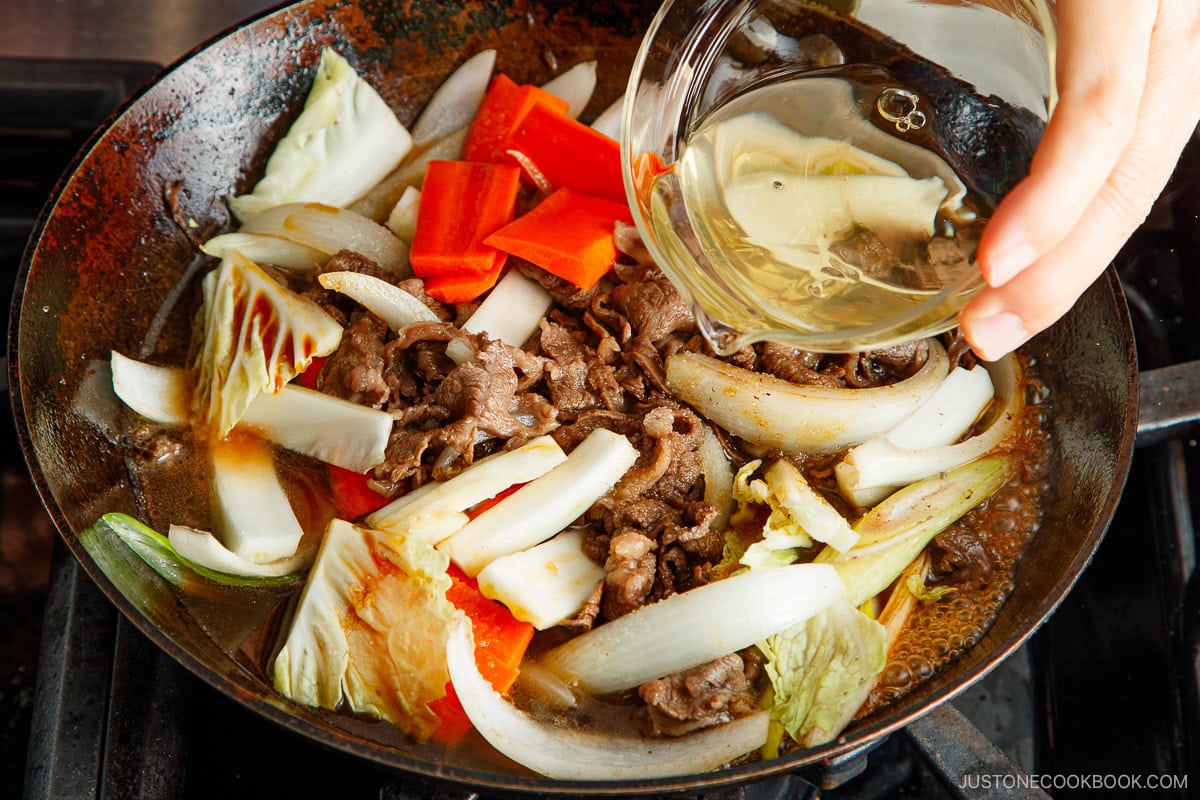
Step 4 – Add the tender vegetables and simmer. Gently push down the vegetables into the broth. Add the tofu, tender napa cabbage leaves, light green negi, and mushrooms, arranging them in sections. Bring it to a boil, reduce the heat, and cover to simmer.
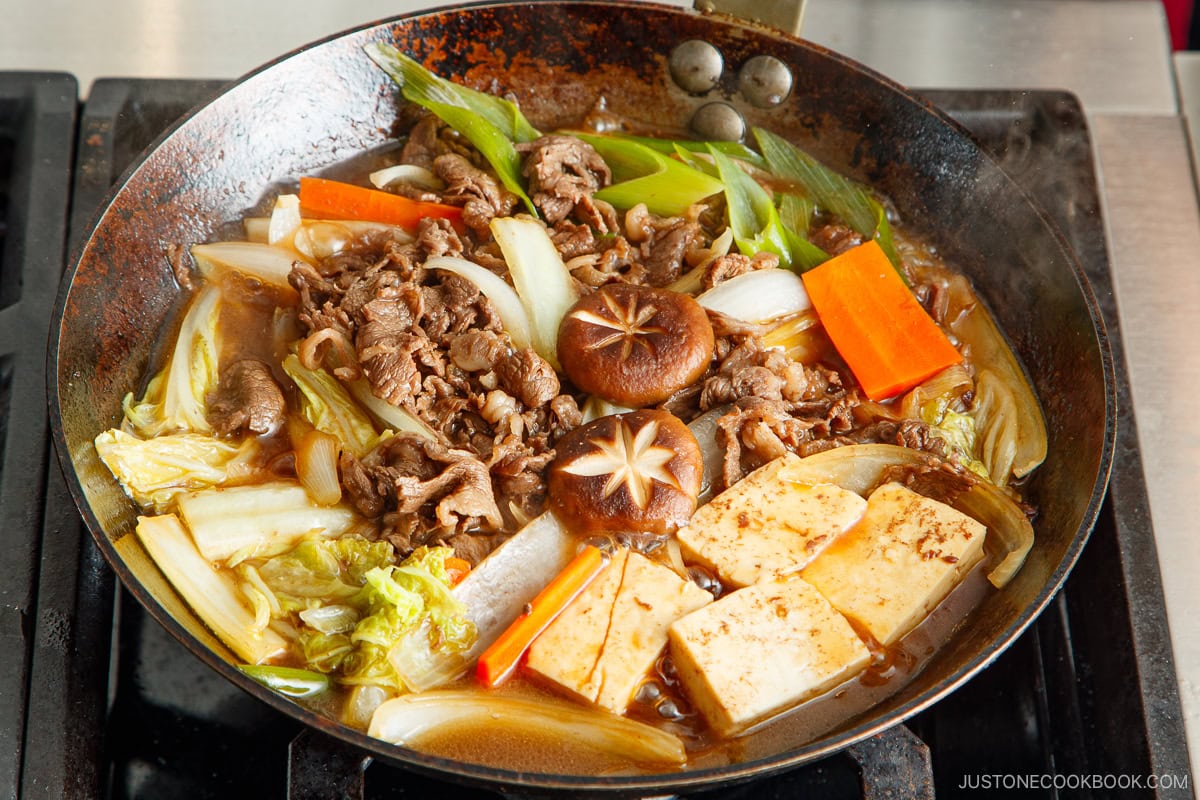
Assemble
Step 5 – Put together your Sukiyaki Don and serve! Prepare a donburi bowl with warm rice. Place the tofu on the side, then add the beef, mushrooms, and vegetables around the bowl. Enjoy!
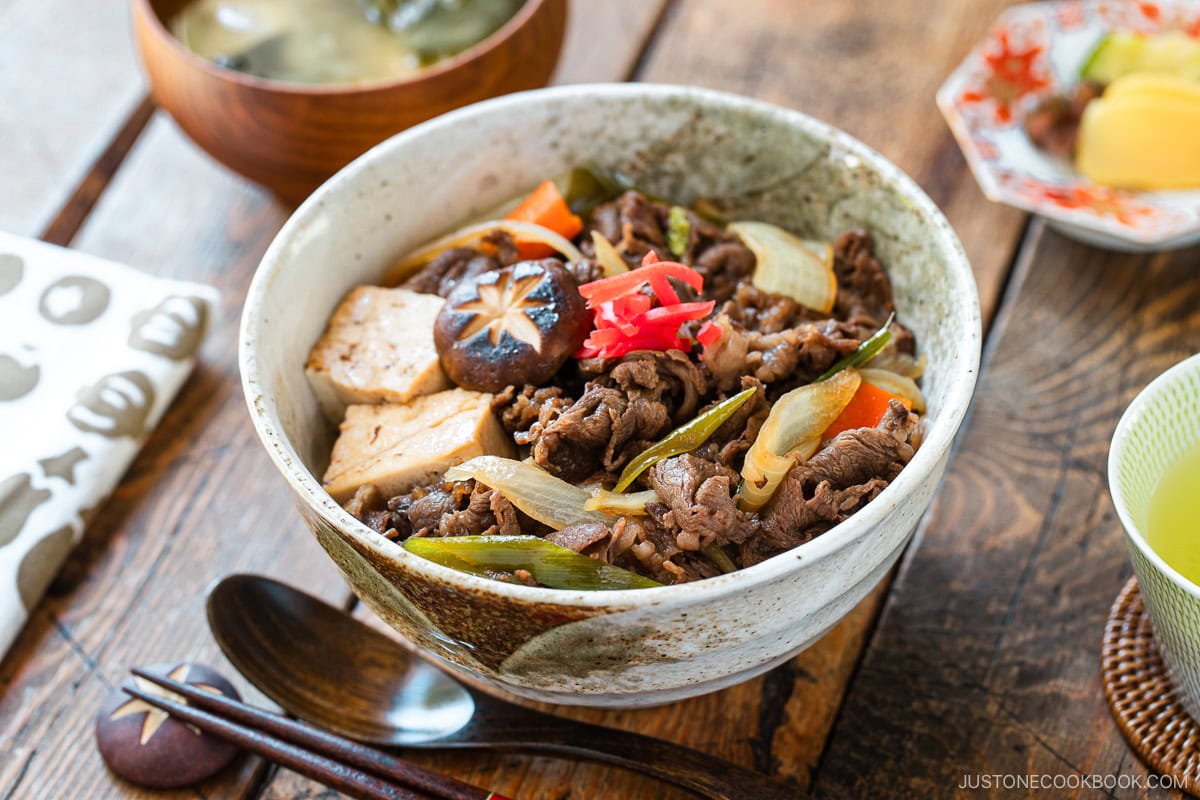
Nami’s Recipe Tips
- Don’t overcook the beefespecially if your meat is not well marbled. You don’t want chewy meat. As soon as the beef is no longer pink, start adding the vegetables and seasoning. If you use well-marbled meat, you can let it simmer slightly longer to allow the meat to absorb the sauce’s flavor.
- Separate the tender and tough vegetables and cook them at different times. To keep the tender, leafy veggies from overcooking, add them to the pan toward the end of cooking. On the flip side, you’ll add the tough, thick veggies earlier to give them the time they need to cook.
- Leave the tofu untouched while it heats through. Once you place the tofu in the pot to simmer, try not to touch it until you’re ready to plate the rice bowl. The tofu can break if you move it or stir the ingredients.
- Taste the sauce and adjust. If your simmering liquid reduces, the sauce may become salty. If this happens, drizzle a tiny amount of dashi or water to rebalance the seasoning. On the flip side, you can add a few more drops of sukiyaki sauce if you prefer a bolder flavor.
Variations and Customizations
- Swap your favorite vegetables. While I include many standard sukiyaki vegetables in today’s recipe, I encourage you to use your favorites. Cabbage, chrysanthemum greens, spinach, watercress, bok choy, and bean sprouts are just a few to try.
- Add shirataki noodles. A typical sukiyaki don often includes shirataki noodles, but I left it out today to simplify this recipe. I hope you give it a try if you have the chance—it adds a wonderful bouncy texture!
- Top it with a poached egg. If you love eggs like I do, feel free to top your donburi with a poached egg or Onsen Tamago for extra protein and a luxurious creaminess.
- Use broiled tofu (yaki tofu). If you can find it, try yaki tofu. I use this grilled firm tofu in my standard sukiyaki recipe for its slightly charred flavor. It’s firmer and denser than regular firm tofu and can withstand long cooking without crumbling. It’s also porous and can easily absorb broths and sauces well.
- Make it meatless. For a vegetarian version, you can use meat alternatives or simply add more tofu and meaty mushrooms like king oyster mushrooms.
What To Serve with Sukiyaki Don
Sukiyaki don has everything you need for your meal in one bowl, so you can enjoy it as is. If you’d like to add variety and a boost of nutrients, here are my simple suggestions.
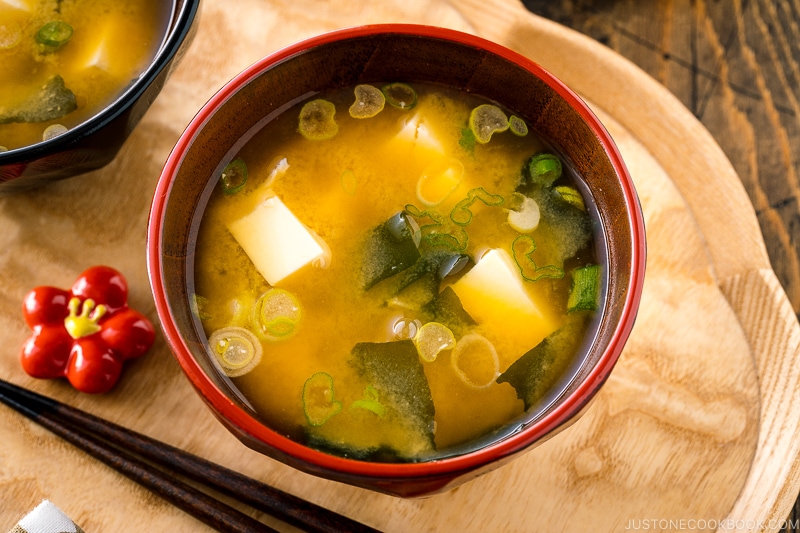
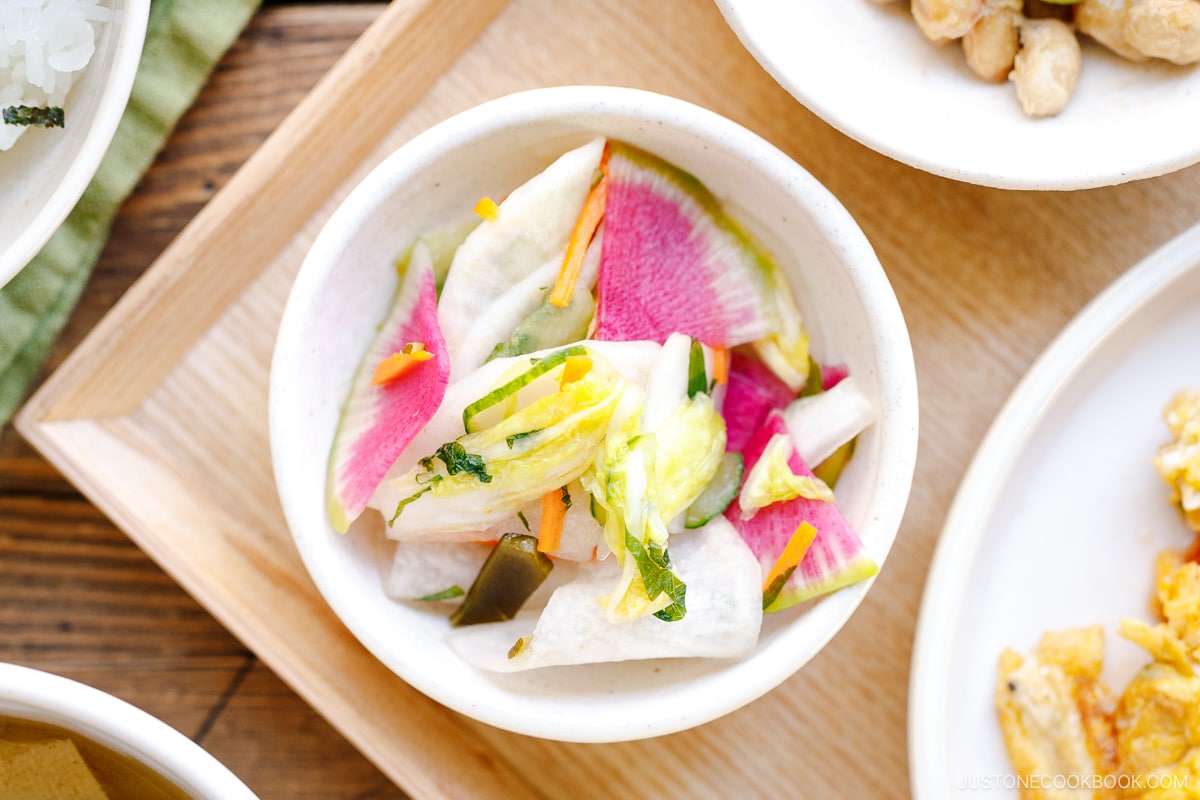
Storage and Reheating Tips
To store: You can keep the leftovers in an airtight container and store in the refrigerator for up to 2–3 days.
To freeze: You can keep the meat and vegetable mixture in an airtight container in the freezer for up to a month. Tofu does not freeze well, so remove it before freezing.
To reheat: Thaw in the refrigerator overnight before reheating. For the best results, reheat the leftovers gently on low heat until warmed through.
Frequently Asked Questions
Thinly sliced meat for Japanese recipes are sold in packages at Japanese markets and other Asian markets. Look for thinly sliced beef chuck or ribeye for shabu shabu (paperthin) or sukiyaki (slightly thicker). If you don’t have access to these grocery stores, check out the ingredient note in the recipe card below.
Unfortunately, soft/silken tofu is too delicate for this dish. For simmered dishes like sukiyaki, the tofu must be firm enough to withstand the cooking process without breaking. That’s why I recommend medium-firm tofu or yaki tofu (grilled firm tofu), if you can find it. In addition to holding their shape, these types absorb flavorful broths and sauces well.
More Beef Rice Bowl Recipes
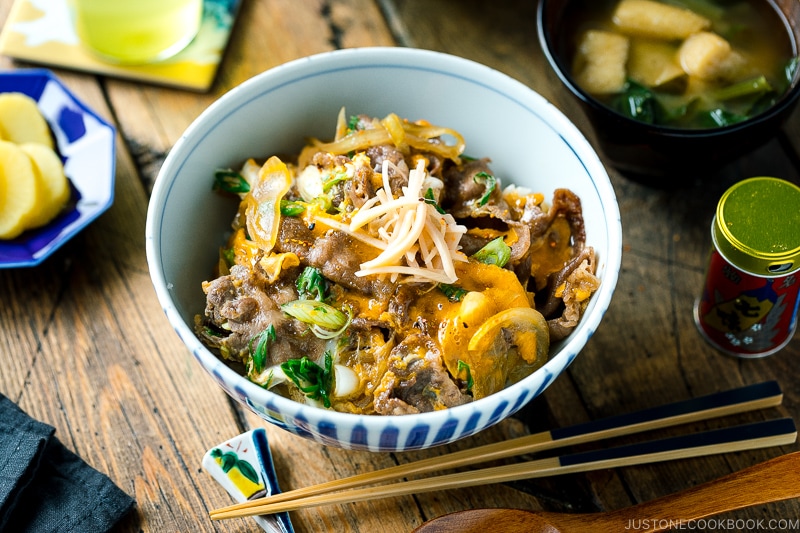
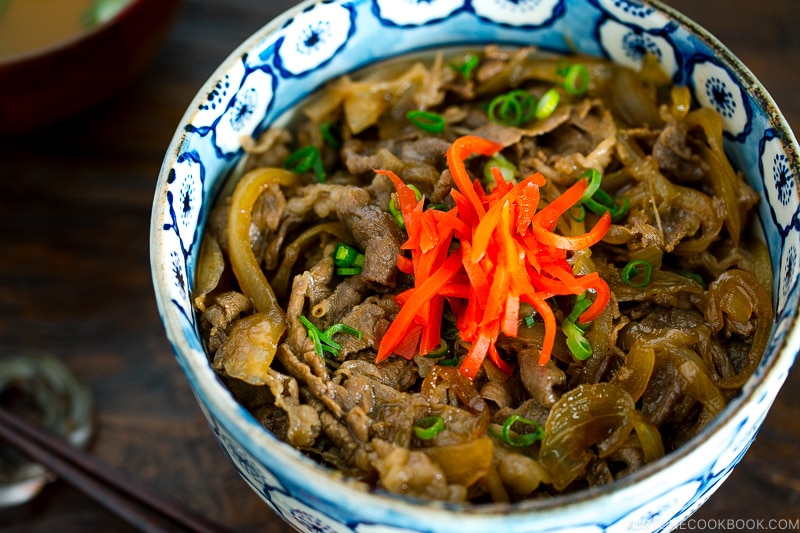
Prevent your screen from going dark
To Cook the Sukiyaki
-
Heat a large frying pan (I use a carbon steel pan) over medium-high heat. When it’s hot, add 1 Tbsp neutral oil and swirl the pan to distribute it. Add the meat to the hot oil, separating the individual slices with cooking chopsticks. Quickly sear the meat until the bottom side browns, then flip the pieces over to sear the other side. Tip: Searing develops a delicious flavor in the beef.
-
While the other side cooks, push the meat to one side of the pan. Add the onions and Tokyo negi to empty side and sear them to develop more flavor. When they are slightly browned, mix them together with the meat.
-
Add the carrot and thick, white pieces of napa cabbage to the pan. Stir to cook.
-
Now, add 3 Tbsp sake, 3 Tbsp mirin, 3 Tbsp soy sauceand 1 Tbsp sugar.
-
Add ½ cup dashi (Japanese soup stock). Use your chopsticks to press down on the vegetables to submerge them in the cooking liquid.
-
Add the tender napa cabbage leaves and light green negi leaves to the pan, arranging them in separate sections. Nestle the tofu pieces in the broth in their own section. Add the mushrooms. Cover the pan to simmer for a few minutes.
-
Check to see if the vegetables are cooked. If not, continue simmering for a few more minutes. When the carrots and napa cabbage are tender, turn off the heat.
To Serve
-
Serve the cooked Japanese short-grain rice in individual large (donburi) bowls. Transfer the sukiyaki on top of the rice and drizzle it with additional sukiyaki broth, as desired. Garnish with optional pickled red ginger (beni shoga or kizami beni shoga) and serve immediately.
To Store
-
Store the leftover sukiyaki and rice separately in airtight containers. You can keep the sukiyaki in the refrigerator for up to 2–3 days or in the freezer for up to a month. Tofu does not freeze well, so remove it before freezing. Thaw in the refrigerator overnight before reheating. Reheat the leftovers gently on low heat until warmed through. You can make fresh rice or reheat the frozen rice. It’s best to store cooked rice in the freezer, where it can keep for up to 1 month. Here’s How To Store Cooked Rice.
©JustOneCookbook.com Content and photographs are copyright protected. Sharing of this recipe is both encouraged and appreciated. Copying and/or pasting full recipes to any website or social media is strictly prohibited. Please view my photo use policy here.

